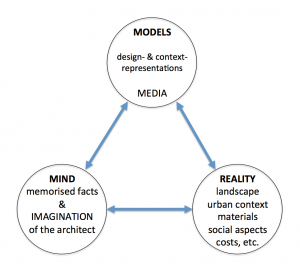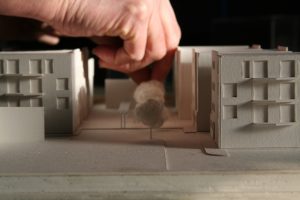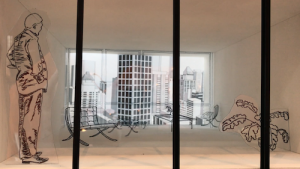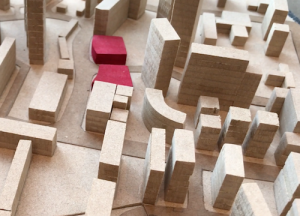2.2.1 Knowledge
Course subject(s)
Module 2 – Your Dream House
Why models?
Preparing a shelter or a place to live is and has been a fundamental activity since the beginning of human life. When we build something we do not just rely on our instincts like birds do when they build nests. We humans need more planning and reflection before constructing.
In order to prepare for these real construction activities, we might have a clear idea in mind, or sketch it out on paper. But images on paper and thoughts in our mind need further development, which is where models can be a great tool to mediate between reality and imagination. They support creative thinking whilst maintaining a logical connection to reality.

For example, a 1:100 scale model of a house represents the design in its spatial set up. The model has walls and rooms that are placed in a similar configuration to the real building. The difference is however that the model is 100 times smaller than the real house. In most cases, the materials in the scale model are not the same as the real materials. The walls could be made from grey board, which represents a real wall made from concrete, plaster, or brick.

Picture of a grey board model made by Joanneke Cuperus, photo made in 2007 by Martijn Stellingwerff.
This is where the imagination comes in. Here, the person who made the scale model used grey board to represent the walls, and this added meaning to the material. Most people who look at the scale model will recognise the pieces of grey board, and understand that they mean ‘walls’ within the context of the model, and that the real walls will not be made from board as this is just a method of representation.
Models in architecture are representations of ideas that bear some spatial relation to the reality. Like images, models have some linguistic aspects. Words in a spoken language can be very abstract. We learn a vocabulary in order to construct sentences, which then enable us to speak. Materials in scale-models are built up of different elements that enable the meaning to be understood from the context.


Imagination from simple materials: A contextual city model made from MDF (medium dense fibre board) and drawings on transparent plastic sheet. Click on the images to see animations.
- The grey board becomes concrete.
- The colour red in the MDF model signifies the importance of the building in the context of the model rather than that the building should be made red in reality.
- The transparent sheet allows the model to be inhabited by plants and furniture to give the viewer an understanding of how the space might be used.
So to conclude, models carry ideas and should not be read too literately.
Next, in the next units we will discuss three different kinds of models: Sketch Models, Analytical Models and Presentation Models.

Models in Architecture by TU Delft OpenCourseWare is licensed under a Creative Commons Attribution-NonCommercial-ShareAlike 4.0 International License.
Based on a work at https://ocw.tudelft.nl/courses/models-architecture-design-physical-digital-models/.



